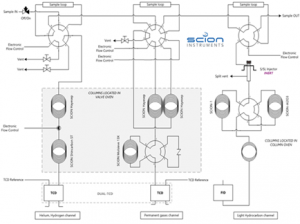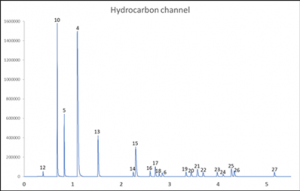ASTM D1946 Refinery Gas Analysis using the SCION Rapid RGA Analyzer
Introduction
SCION Instruments offers a solution for the fast analysis of refinery gas streams: The Rapid Refinery Gas Analyser (RGA). The Rapid RGA determines the chemical composition of reformed gas and similar gaseous mixtures containing the following components: Helium (He), Hydrogen (H2), Oxygen (O2), Nitrogen (N2), Carbon monoxide (CO), Carbon dioxide (CO2), C1-C6+ hydrocarbons isomers and Hydrogen Sulfide (H2S). All in one single analysis within 6 minutes. CompassCDS software will provide complete analyser control, data acquisition and flexible report generation.
SCION Instruments Gas Chromatographs are equipped with industry standard, robust high-quality hardware that ensures maximum up time of the instrument.
The Rapid RGA configuration is optimised for compliance with ASTM D1946 and ASTM D2163. Other methods which can be met by the Scion Instruments Rapid RGA are for example ASTM D2504, ASTM D7833, ASTM D2593, ASTM D4424, IP405/ISO7941/EN27941, EN15985 and UOP539, although minor modifications may be required.
For enhanced sample introduction, the Rapid RGA can be optionally equipped with an integrated micro-gasifier. This sample conditioning device ensures complete vaporisations of LPG’s and high-pressure samples to prevent any sample discrimination prior to injection. Another option for the Rapid RGA is the use of liquid sampling valves.
SCION Instruments Rapid RGA analyser is implemented on the 456-GC platform, as shown in figure 1. The gas chromatograph consists of three independent analytical channels.
Figure 2 shows a flow diagram of the Scion Instruments Rapid RGA. The first channel is optimised for the analysis of helium and hydrogen. The second channel is optimised for the analysis of permanent gases, and the third channel is designed for light hydrocarbons.

Figure 1. SCION 456-GC Rapid Refinery Gas Analyser

Figure 2. Plumbing scheme for the Rapid RGA analyser
Materials and Reagents
For the analysis a synthetic refinery gas blend was used, composition and peak identification numbers are listed in table 1.
| Peak Nr. | Component | % | Peak Nr. | Component | % |
| 1 | Helium | 0.1 | 15 | Propylene | 5.0 |
| 2 | Hydrogen | 1.0 | 16 | iso-Butane | 0.5 |
| 3 | Carbon Dioxide | 1.0 | 17 | n-Butane | 1.0 |
| 4 | Ethylene | 24.9 | 18 | Propadiene | 0.6 |
| 5 | Ethane | 5.0 | 19 | t-2-Butene | 0.5 |
| 6 | Acetylene | 1.0 | 20 | 1-Butene | 0.5 |
| 7 | Hydrogen Sulphide | 1.0 | 21 | Iso-butene | 1.0 |
| 8 | Oxygen | 1.0 | 22 | cis-2- Butene | 0.5 |
| 9 | Nitrogen | 5.0 | 23 | iso-Pentane | 0.5 |
| 10 | Methane | 24.9 | 24 | n-Pentane | 0.2 |
| 11 | Carbon Monoxide | 0.5 | 25 | 1,3-Butadiene | 1.0 |
| 12 | Hexane | 0.2 | 26 | propyne | 1.0 |
| 13 | Propane | 5.10 | 27 | Ethyl Acetylene | 0.5 |
| 14 | Cyclopropane | 0.5 |
Table 1. Composition of test gas
Results and Discussion
The Rapid RGA analyser is a 3-channel multi-valve, multi column system. Each channel has the ability to operate independently with the sample line connected in series. The sample is sent through the three sample loops feeding the three GC channels.

Figure 3. Helium and Hydrogen chromatogram from the front TCD channel.
The front TCD channel is a helium and hydrogen channel, as shown in figure 3. The sample is injected by means of a gas-sampling valve onto a Hayesep column. The first fraction containing Helium and Hydrogen is flushed onto a shincarbon ST column; the rest is backflushed to the vent. Helium and Hydrogen are detected by a TCD. The repeatability of this channel can be found in table 2.
| Component | RSD% (area) | Component | RSD% (area) |
| H2S | 0.41 | CO2 | 0.09 |
| O2 | 0.08 | C2H4 | 0.08 |
| N2 | 0.09 | C2H6 + C2H2 | 0.11 |
| CH4 | 0.09 | He | 0.09 |
| CO | 0.81 | H2 | 0.1 |
Table 2. Repeatability figures of the hydrogen and permanent gas channel (front and middle)
The middle TCD channel analyses the permanent gases. The Permanent Gas channel is developed for the simultaneous determination of CO2, the C2 isomers, H2S, O2/Argon (Ar), N2, Methane (CH4) and CO. The sample is injected by means of a gas-sampling valve onto a series of Hayesep columns. The fraction containing O2, N2, CO and CH4 is flushed onto a Molecular Sieve column and parked. CO2, the C2 isomers and H2S elute to the TCD, bypassing the Molecular Sieve column. After the elution of H2S, the Molecular Sieve column is set in flow again, giving the separation of O2/ Ar, N2, CH4 and CO.
Figure 4 shows a chromatogram of the permanent gas channel. Repeatability figures of the front and middle channel are presented in Table 2. With relative standard deviations of 0.3% and lower, the system is perfectly capable of analysing these types of components.

Figure. 4 Permanent gases chromatogram from the middle TCD channel (components 5 & 6 are separated on the rear channel).
Light hydrocarbons are analysed on the rear FID channel which is equipped with a full ceramic flame tip. The Light Hydrocarbon channel determines the range of low boiling hydrocarbons and isomers, C1 – C5 and C6+ (as composite peak). The sample is injected by means of a gas-sampling valve onto the pre-column (SCION-1). The components having a boiling point of below C6 are transferred onto the Al2O3/Na2SO4 column. The highly selective column separates all individual isomers from the light hydrocarbon fraction, as shown in figure 5. The fraction with a boiling point of C6 and higher is backflushed from the pre-column to the FID, resulting in a peak representing the higher boiling fraction.

Figure 5. Light hydrocarbon chromatogram from the rear FID channel.
Conclusion
Scion Instruments provides a robust, high resolution, complete solution for refinery gas streams; the Rapid Refinery Gas Analyser. The Scion 456-GC Rapid RGA is equipped with industry standard and inert GC hardware. The analyser is easy to service due to great accessibility and minimal downtime.
This analyser determines the chemical composition of reformed gas and similar gaseous mixtures. With a relative standard deviation for all components below 1%. The Scion Instruments Rapid RGA is perfectly suited for the analysis of refinery gases of different sources.
If customisation is required, please contact our pre-sales experts.
Download the Application Note
Download the complete Application Note: Refinery Gas Analysis using the Scion Rapid RGA Analyser
Keep in Touch
If you wish to speak to a member of our team about more information, please don’t hesitate to contact us. Or if you wish to keep up to date with SCION Instruments latest research and articles, why not join us on social media and sign up to our newsletters today?
